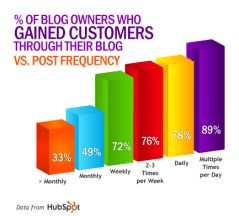 If you haven’t asked yourself if less is really better lately, then you should.
If you haven’t asked yourself if less is really better lately, then you should.
Here are some unexpected examples of where less is really better:
- Fewer leads
- More cost
- Fewer employees
- Less space
- Fewer tools
- Fewer platforms
- Less content
I’m sure you don’t believe me, but let’s delve into these examples of where less is really better.
Fewer leads
In generating leads, less is really better.
For some of my clients, generating a lot of leads is their primary marketing goal. So, why am I arguing that fewer leads is better?
 Because a lead is just a lead — nothing more, nothing less. What you really want are customers, right? Leads are only interesting in that they’re the first step down the conversion funnel to becoming customers.
Because a lead is just a lead — nothing more, nothing less. What you really want are customers, right? Leads are only interesting in that they’re the first step down the conversion funnel to becoming customers.
And, you really don’t care about customers, for that matter. What you care about is revenue. So fewer customers isn’t really a problem and shouldn’t be a goal.
What you should be looking at is CLV (customer lifetime value) and doing yield management to maximize the CLV per customer.
Adding high CLV customers is much better than keeping existing low CLV customers. Increasing the CLV of customers is preferable to adding new customers.
Increasing your conversion rate is preferable to generating more leads.
The number of leads is a useless metric.
The entire sales process was turned on its ear by inbound marketing, which transfers power from the seller to the buyer. Buyers no longer have to reach out to you (becoming a lead) before they buy. If you’ve done it right, they have all the information they need right on your website or in your social feeds. They can go straight from strangers to customers with a single sales call without ever becoming a lead or generating incremental costs.
Isn’t that great!
More cost
Most folks think spending less is really better. No accountant worth his/ her salt would recommend increasing costs.
But, marketers aren’t accountants. We know spending more for a lead might generate a higher quality lead in terms of CLV [source].
Similarly, spending more to get high-quality employees is better than spending less on a mediocre employee [source].
And, you should spend more on better materials to make more profit [source].
If we learned nothing from the ’80, we killed the concept of shrinking to greatness [source]. While great advantage comes from operating lean, indiscriminate cost cutting often reduces expenses, like routine maintenance, that actually cause higher costs in the long run.
Get my meaning?
Fewer employees
Having too many employees may be more deadly than having too few [source].
Work expands to fill the time available. With too many employees, clunky procedures and wasteful processes develop. When there’s more work, the staff available can’t get it done because they’re hampered with these legacy systems.
Too many employees also leads to political problems and turf warfare that are counterproductive to efficient operation.
Having too many employees leads to unwieldy bureaucracies that slow down the company.
Less space
Less is really better when you think about space, as well.
In traditional organizations, c-suite folks had massive offices and the size of the office declined as the employee’s rank declined.
 One aspect of lean is the realization that we don’t need all this space. In fact, employees work better, more efficiently, with fewer conflicts when they work in a combined space, rather than individual offices. Google, for instance, has pods where cubicles are adjacent to open spaces for chatting and kitchen areas for refreshment, all combined in an open floor plan that’s very fluid.
One aspect of lean is the realization that we don’t need all this space. In fact, employees work better, more efficiently, with fewer conflicts when they work in a combined space, rather than individual offices. Google, for instance, has pods where cubicles are adjacent to open spaces for chatting and kitchen areas for refreshment, all combined in an open floor plan that’s very fluid.
Rumor has it, even Mark Zuckerberg, of Facebook, has a cube rather than a big fancy office.
The same goes for manufacturing space. I once consulted with a client who had a very dysfunctional manufacturing facility that added significantly to cost, just because they could. Rather than constructing a facility where machines involved in a process were nearby, they simply set new machines down in any available space. If they’d had a smaller space, they would be forced to be smarter in where they placed equipment, forcing them to make an effort to design a smart process.
Fewer tools
I’m really a fan of using as few tools as possible to get the job done — preferably 1 tool.
This is a great example of where the less is really better. Too many tools results in a lack of coordination, duplication of efforts, and confusion. It also makes analytics a nightmare.
The same goes for fewer platforms — social platforms in particular. Is less really better? Absolutely. Having too many social platforms, jumping on the bandwagon of the current platform du jour, and having legacy platforms just hanging around all damage your reputation when you don’t have the resources to coordinate and post fresh, valuable content on a routine basis.
I once consulted with a company that had the same product sold through 4 or 5 different companies. Each had its own website and social media. It was a nightmare just to keep everything straight. Instead, I recommended having a single website with different pages for different target markets rather than different companies and websites.
Less content

Some businesses think that if content is good, more content is better. It’s been a constant discussion among marketers as to the proper balance between quantity and quality.
For me, I’ll come out on the side of quality every the time.
But, there are limits where less is really better. Notice this graphic from Hubspot. Note that there’s a big drop-off when content is less than weekly. The change between weekly and multiple times per day isn’t as great as when you create content less than once per week. For my clients, I come out with a preference for 2-3 posts/week. I find this is the sweet spot between what is best and what is possible with the given resources.
Some final thoughts
It’s common practice to assume that more is better. I don’t agree. Throwing money at a problem doesn’t always fix it and may make it worse. Instead, you should be throwing smarts at a problem — figure out what it takes to get where your REALLY want to be, the figuring out what it’ll take you to get there.
In many cases, less is really better. If nothing else, it forces you to use resources wisely.
Business & Finance Articles on Business 2 Community(58)
Report Post







